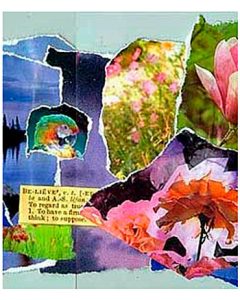Are you art journaling with mixed media and ephemera?
 Do you struggle to collect and organize collage photos, papers and ephemera?
Do you struggle to collect and organize collage photos, papers and ephemera?
Here’s the system that works well for me. It might help you, too.
Art journaling – and mixed-media collages – can require lots of images. And, to remain “in flow” as you’re creating a new journal entry (or embellishing an older one), organization can be vital.
Here are some tips to keep the clutter under control.
Step One: Sort collage elements into groups
Start by deciding how you think about your collages.
- Are you primarily color-focused?
- Or, do you choose images by themes, such as Nature, Anime, Steampunk, Skies, and so on?
For me, all of my art – including my collages and art journaling pages – is often about color.
So, I organize my loose images into the major color groups (red, blue, green, etc.) and then expand (lime green, turquoise, etc.) as my collection of saved images becomes too large for anything simpler.
Usually, I store them in individual manila folders, based on the main color in the image.
Then, when I want something blue, I open my “blue” folder and I’ll see my primarily blue magazine images, but also blue tissue paper, maybe some bits of blue ribbons or fabrics that I intend to use in collage, and so on.
However, I’ve also started folders that say things like “skies” and “green plants.”
Think about how (and what) you look for elements and ephemera to add to your collages as you work on them.
Also, look at your existing collages. Your categories might be “faces” or even more specifically, “women’s smiling faces,” etc. Or, “nature,” “dark-looking castles,” “cute cottages,” “kissing,” “fast cars,” “vintage images,” or whatever.
Create categories that work for you and your creative process.
Step Two: Keep those folders tidy.
Having a bunch of folders, no matter how well they’re filled with juicy, colorful images, is just the first step.
Then, they need to be accessible.
For me, that means a standard file box with hanging files.
All the blue-related folders (turquoise, sky blue, navy) go into one hanging file. All the photos of forests from travel magazines and National Geographic go in another hanging file, along with a folder that’s gardens and another that’s houseplants. And maybe honeybees and butterflies.
Optional Addition: Bins.
As I work on a collage and tear off pieces, I’m often left with shreds and shards of paper that are too good to throw out.
When that happens, I put them into small bins. In my case, I’m recycling plastic sandwich meat containers from Target. (My family’s favorite ham comes in those containers.)
I have one for blues and greens. One for glittery ephemera. One for ribbons, feathers, and so on.
You get the idea, I’m sure.
When I’m just NOT finding the collage element I need, I open those bins and usually find the perfect element.
Either that, or – looking at those bits – I have an “ah-HA!” moment and know where to look for the element I need. Usually, that’s a magazine or travel brochure from my stack of unread future collage resources.
Why to Stay Organized
If you’re like me, you create your best art when you’re “in flow.” Anything that interrupts can affect the journal page or collage that I’m working on, and not in a good way.
So, the more I can create systems that work intuitively for me, and keep everything organized, the happier I am as an artist.
Find (or create) systems that work for you and keep you organized.
I know that can be a challenge for artists, but it’s also essential for us to create our very best work.
Amazon and the Amazon logo are trademarks of Amazon.com, Inc, or its affiliates. As an Amazon Associate, I earn from qualifying purchases.